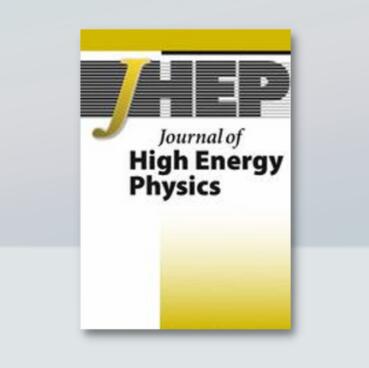Intersection theory, relative cohomology and the Feynman parametrization
IF 5.4
1区 物理与天体物理
Q1 Physics and Astronomy
引用次数: 0
Abstract
We present a novel approach for loop integral reduction in the Feynman parametrization using intersection theory and relative cohomology. In this framework, Feynman integrals correspond to boundary-supported differential forms in the language of relative cohomology. The integral reduction can then be achieved by computing intersection numbers. We apply our method in several examples to demonstrate its correctness, and discuss the subtleties in certain degenerate limits.
交点理论,相对上同调和费曼参数化
利用交理论和相对上同调提出了一种新的Feynman参数化环积分约简方法。在这个框架中,费曼积分对应于相对上同调语言中的边界支持的微分形式。然后可以通过计算交集数来实现积分化简。我们用几个例子证明了该方法的正确性,并讨论了某些简并极限下的微妙之处。
本文章由计算机程序翻译,如有差异,请以英文原文为准。
求助全文
约1分钟内获得全文
求助全文
来源期刊

Journal of High Energy Physics
物理-物理:粒子与场物理
CiteScore
10.30
自引率
46.30%
发文量
2107
审稿时长
1.5 months
期刊介绍:
The aim of the Journal of High Energy Physics (JHEP) is to ensure fast and efficient online publication tools to the scientific community, while keeping that community in charge of every aspect of the peer-review and publication process in order to ensure the highest quality standards in the journal.
Consequently, the Advisory and Editorial Boards, composed of distinguished, active scientists in the field, jointly establish with the Scientific Director the journal''s scientific policy and ensure the scientific quality of accepted articles.
JHEP presently encompasses the following areas of theoretical and experimental physics:
Collider Physics
Underground and Large Array Physics
Quantum Field Theory
Gauge Field Theories
Symmetries
String and Brane Theory
General Relativity and Gravitation
Supersymmetry
Mathematical Methods of Physics
Mostly Solvable Models
Astroparticles
Statistical Field Theories
Mostly Weak Interactions
Mostly Strong Interactions
Quantum Field Theory (phenomenology)
Strings and Branes
Phenomenological Aspects of Supersymmetry
Mostly Strong Interactions (phenomenology).
 求助内容:
求助内容: 应助结果提醒方式:
应助结果提醒方式:


